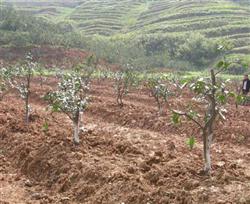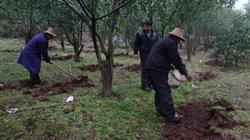How to prune oranges and control diseases and insect pests in summer?

How to prune oranges and control diseases and insect pests in summer? Please give a detailed introduction of summer citrus pruning and pest control can refer to the following methods: the main methods of summer pruning are as follows: first, the branch group beyond the crown is retracted to the 0.5 cm-1 cm 2-year-old branch of the branch group; the second is the strong spring shoot growing upright, leaving 3-5 leaves short; the third is to cut off the single apical fruit on the strong fruiting branch. Fourth, the fallen flower and fruit branch retracted it to the spring tip section of last year; fifth, if it bore fruit in the back section of the fruiting mother branch, it retracted to the first section-2 section of the fruiting position. The strength of summer shears, depending on the size of the crown, the age of the tree and the number of fruits, is normally 100-150 cuts. The cuts should be evenly distributed on the crown. From July to September, scale insects, rust wall lice and leaf miner are the most harmful periods. The scale insect can be controlled with 1000-fold solution of 90% trichlorfon or 1000-1000 times of isocarbophos, rust wall lice can be controlled with 1000-fold solution of 20% trichloropropanol and 500-fold solution of 25% chlordimeform. Control leaf moth with 1000-1500 times of 50% dichlorvos. Whitefly whitefly is one of the main pests of citrus. It is mainly caused by larvae clustered on the back of leaves to suck juice, and can also cause macula on the front of leaves and pericarp, induce bituminous coal disease at the same time, affect photosynthesis, weaken tree potential, and serious trees can cause falling leaves and fruits. Whitefly whitefly occurs four generations a year, and the egg hatching peak of each generation occurs in the following range: the first generation from May 30 to June 13; the second generation from July 12 to July 26; the third generation from August 28 to September 15; and the fourth generation from October 23 to November 9. In order to control whitefly whitefly, insect pests and weak branches should be cut off, weeds should be ploughed and weeded frequently, cultivation management should be strengthened, so that the orange orchard can be ventilated and transparent and the tree potential should be enhanced. Pay attention to the protection and utilization of natural enemies. In orange orchards with few parasitic natural enemies, spraying one or two times in time during the peak incubation period of each generation can effectively control its damage. Chemical control can use 80% dichlorvos emulsion 500 times, 40% dimethoate or omethoate emulsion 800 times, 40% fast killing emulsion 700 times, 25% pine alkali mixture 18 times-25 times; in orange orchards where parasitic natural enemies occur more, dichlorvos, dimethoate and other agents should be used in the pupa stage of spiny lice. Click to get more citrus planting techniques click to get more fruit planting techniques
- Prev

How to grow oranges to prevent drought?
How to grow oranges to prevent drought? Please give guidance to citrus cultivation vulnerable to spring drought and summer drought. Spring drought mainly occurred from February to May, which was characterized by affected flower bud differentiation, low water and abnormal shedding of late-maturing citrus, curly leaves, increased abnormal flowers, granulation and water loss of fruit cysts, decreased quality and flowering.
- Next

How to manage oranges in July?
How to manage oranges in July? Please introduce that citrus in July can be managed with reference to the following methods: (1) Fertilizer and water management is easy to meet high temperature and summer drought in July, and the chance of rainstorm is also significantly increased. Therefore, all localities should pay special attention to the weather forecast of local meteorological stations and use straw in tree plates in case of drought.
Related
- Moge, come on! The staff of the peasant association in the producing area of cantaloupe were frightened when the crowd gathered.
- Causes and Solutions of low Fruit setting rate of Apple
- Symptoms and control measures of passion fruit virus disease
- Fruit growing lesson: how do apple orchards keep high yields?
- Can you build orchards in the mountains? What are the pros and cons?
- How to manage the coloring period of Crisson grape?
- This paper introduces the processing technology of two kinds of fig products.
- How much is a month for retired teachers in rural areas by 2020?
- How can strawberry planting increase sugar content? We should pay attention to management in many aspects.
- What are the cultivation techniques on how to improve the yield of golden fruit?

